Subterranean Termite Control Singapore (The “White Ants” Exterminator)
How to get rid of termites (Subterranean Termites, Drywood & Dampwood Termites Singapore)?
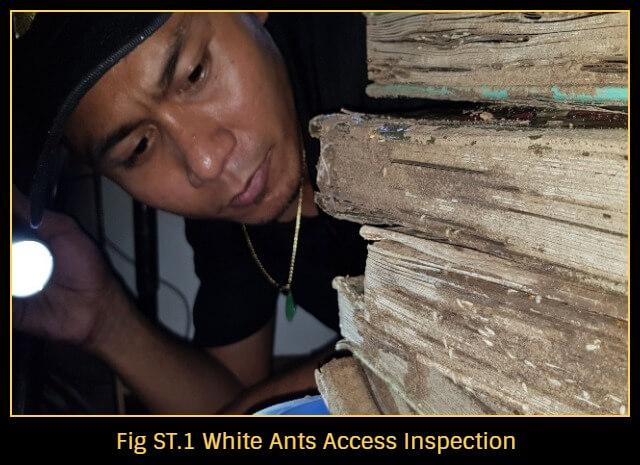
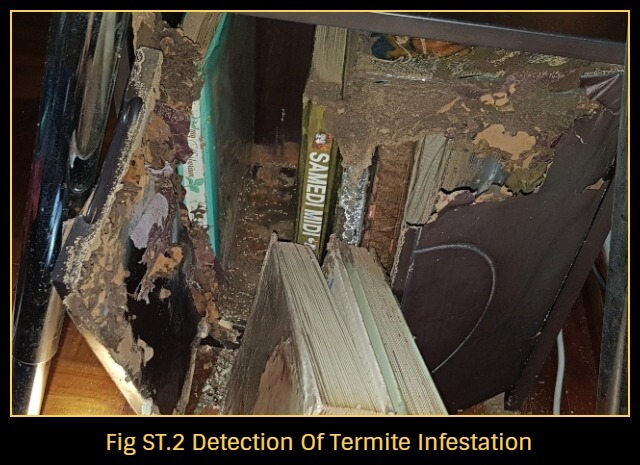
Pesticon’s termite treatment Singapore: Depending on the type of termite infestation, various termite treatment options are available, for different types of termites in Singapore. Generally, for Subterranean Termite treatment, termite baiting system and termite spot treatment are the most common. Whereas for Drywood Termite treatment, foaming and termite treatment for wood are the main forms of Drywood Termite control. Lastly, for Dampwood Termites in garden, drenching and termite spray for wood, provide long lasting anti termite control. Since the best way to treat termites, varies from species to species. It’s important to identify the type of termite, before determining the correct termite solutions. As a guide, if termite tubes are spotted, then it’s sure to be Subterranean Termite mud tubes, as no other types of termites, build mud tubes. However, if there are no tubes and only gathers of sand like particles piling up. Then it’s the termite frass, from the either the Drywood Termites or the Dampwood Termites. Since Dampwood Termites prefer timber with high moisture content, it’s not that difficult to tell them apart, based on the environment. For more information, about the differences in different types of termites, symptoms of termites infestation and termite control methods please read on.
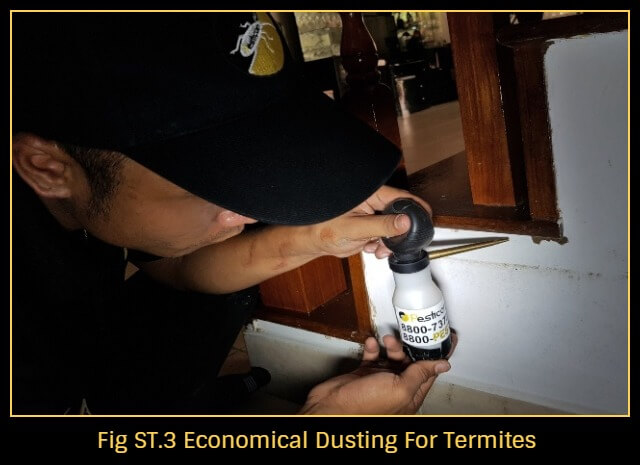
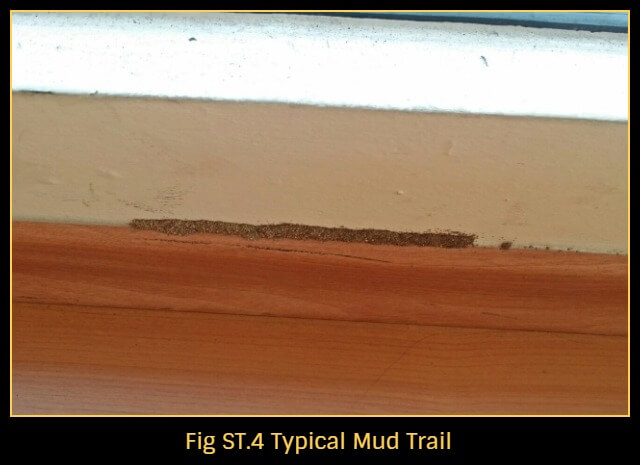
How do you know if you have termites? Signs of termites in house.
Since Subterranean Termites are ground termites, it’s natural for them to traverse, their underground tunnels most of the time. As they forage underground, in our highly urbanised and built up landscape. It’s only a matter of time, that they will encounter, the structural columns of our properties. Any cracks in these columns, or even the walls of basement carparks, will allow them entry. Once in, they will gradually seek out edible timber, by moving through wall voids, wiring conduits, etc. They are able to do so, without breaking surface or building any visible mud tube (termite trail). A good case in point is the common infestation of door frames. Most of the time, property owners don’t even realise, they have an active infestation until door frames are half eaten and all too late. Although termite trails serve as primary evidence of termites, they must be investigated further, to ascertain if the infestation is existing. Since moisture attracts termites, any wooden structure in close proximity to any water source, seepage and leakage, must be checked regularly, for signs of termite damage. To the untrained eyes, any termite infested wood, looks largely the same as a new piece, as termites consume from the inside out. However, there are some clues which can suggest, that your property may be infested with termites. Apart from the regular mud trails, keep a lookout for buckling wood, hollow sensation in wooden floors, termite holes and gypsum boards that swell at seams. Aside from structural inspections, regular post-cleaning checks can help reveal, wings shed from swarmer termites aka “flying ants”. The sighting of multiple wing piles indicates an existing problem of flying termites in house, and that suggests a full-blown infestation. A termite check can be auditory as well. If you suspect, you have termites in furniture next to the walls, put your ears near to the affected areas. You might just hear, their infamous clicking sound. The termite clicking sound is actually, not the sound of termites eating wood. It’s the way, Subterranean Termites communicate with each other, by banging their heads against the tunnel walls. If you need help, in getting a termite house inspection done, or if you wish to engage, a termite control company, for your regular termite service, call Pesticon at 8800-7378 (8800-PEST). We aim to be your best termite control company, providing you with value-added and affordable pest control services.

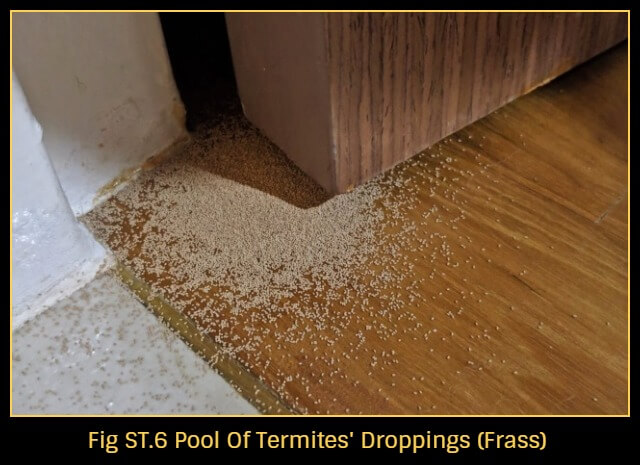
Advanced pest control Singapore (Subterranean Termite Management)
Anti termite control systems generally fall within 3 categories. Namely prevention, monitoring and extermination. Termite prevention treatment includes pre construction termite treatment, post construction anti termite treatment and wood treatment against termites. Apart from regular bimonthly inspections, the next most common form of termite monitoring system, is the deployment of termite monitoring stations (e.g. in ground termite bait stations). When it comes to the termite extermination process, we practice the following termite eradication methods. Namely termite powder treatment (dusting), outdoor and indoor termite bait system. Read on as we explain them in greater details.
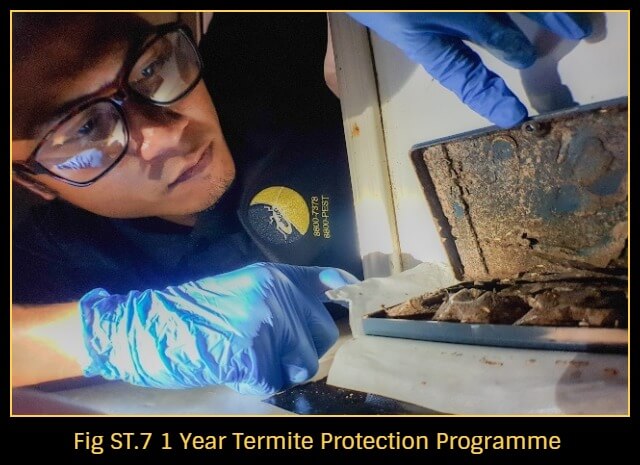
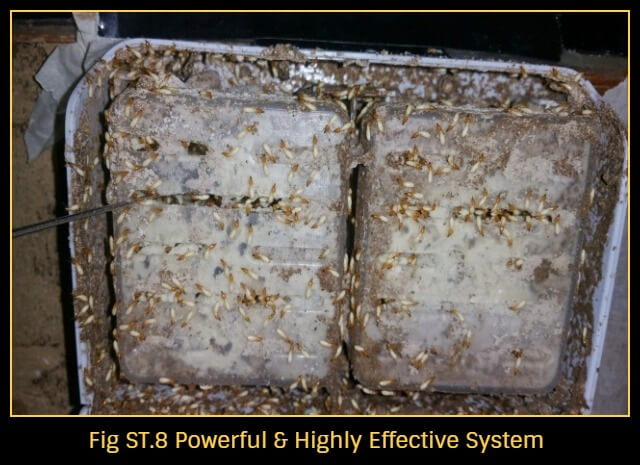
Termite soil treatment (Pre construction termite control)
The pre construction soil treatment for termites (Anti termite treatment to foundation) is a process, where a non-repelling and premium termiticidal solution, is being pressure sprayed on to a plot of land. This process must be carried out, prior to any concreting & construction works. The applied termite solution will form an undetectable termite protection zone, offering immediate colony management benefits. Any termite that passes through this zone, besides dying from insensible poisoning, will also cause secondary poisoning, to other neighbouring termites. All soil treatment clients enjoy a 5 years warranty and a free termite inspection, every single year during the 5 years period. The typical termiticide includes Fipronil based solution like Agenda 10SC.
Corrective treatment (Post construction termite control treatment)
The corrective treatment (Termite liquid treatment), is a type of post construction termite treatment, that functions similarly to pre-construction soil treatment. The main difference lies in their application procedure. The primary idea behind such anti termites in soil treatment is to create post construction termite barriers, that will offer significant protection and bring about termite elimination, through colony management. However, since corrective treatment is designed for built-up land, the anti termite treatment procedure differs. Drilling and coring will be done at regular intervals, for the entire perimeter of the premises. Each hole will then be injected with 5 litres of premium termite pesticide. After which, they will be filled with waterproofing cement. The termite insecticide used, has the same colony management effect, as the termiticide for soil treatment. Our corrective treatment comes with 5 years termite warranty and 5 years of free annual inspection against termites. Typical termiticides include Altriset (Chlorantraniliprole) & Optiguard Termite Liquid (Thiamethoxam).
Wood borer and wood termites control spray (How to prevent white ants in wood?)
The wood treatment against termites (Termite prevention spray), is a process where parquet flooring, timber roof truss, cabinet backing, furniture, etc, can have enhanced protection against termites and other wood borers (Woodworm, Powderpost Beetle, etc). This form of post construction termite proofing is comparable to termite roof treatment. For a typical roof treatment, parts like struts, joists, batten, rafters, beams, etc, will be coated 2 times with termite prevention products.
Termite spot treatment – termite powder (Cheapest pest control Singapore)
When it comes to termites in house treatment, the termite dusting powder, as compared to other termite control products, is one of the most common termiticides, used by termite and pest control companies. For the older generations, this is one of the main ways to kill termites aka white ants. Although age-old in technology, termite dusting offers fast localized control, with the possibility of eradicating, the colony of a termite infested house. That is why most White Ants pest control companies, still offer dusting as a form of White Ants control. White Ant treatment through dusting, is performed by gently puffing, all infested mud tubes with termiticidal dust. The dust is meant to coat, the inner circumference of the treated tubes and any live termites in the line of fire. Termites not caught in the initial swirl of dust, will still pick it up when they forage through treated surfaces. As these affected termites continue to forage, they will inadvertently contaminate their colony mates, through contact and trophallaxis. As a guide, in 7 to 10 days after any dusting treatment, we will conduct a follow-up check, to ensure all treated areas are immaculately clear of any infestation. While dusting is known to be a fast way to get rid of termites in house structures, it should not be relied upon, as the only type of anti-termite treatment in buildings.
Proven termite baiting system with warranty (Termite control Singapore)
Termite baiting is a systematic and formidable process, in which Subterranean Termites are lured and tricked, into consuming and distributing termites poison bait. Besides being a practically non toxic termite treatment, it’s amazingly effective and convenient. In this form of termite management, no pumping of termite chemicals, trenching, drenching and drilling of holes are required. In a typical baiting process, the premises will be meticulously checked for trails. All structures and furniture will be checked for active termite infestation. Bait cartridges containing ultra-high grade cellulose, laced with chitin synthesis inhibitors, will be loaded into termite bait stations and installed at the site of infestation. As the termites forage into one of these bait stations, they will start ingesting the highly attractive and palatable bait. After which, the foraging termites will share the bait, with the rest of the colony, through a process known as trophallaxis. The beauty of such baiting systems, lies in the non-repelling and slow acting nature of the active ingredient. Affected termites do not die immediately. Since the termites are unaware that they are intoxicated, they will continue to travel back and forth from the feeding site to the nest, sharing food (termite bait) as they go. This continues until the termites finally collapse, a few weeks later, when they attempt to moult. Such an occurrence is due to the poisoning effect, of the active ingredient (Chitin Synthesis Inhibitor), that they have been loading up in their bodies, all these while as they feed. The inhibitor functions as an anti-moulting agent and when consumed, interrupts the termites’ growth and moulting. This results in premature death and ultimately the demise of the entire colony. As far as we are concerned, baiting is truly the most effective termite treatment. Like all the best termite treatment companies, we are the authorised installer for Exterra termite baiting system, Exterminex termite bait and Xterm termite baiting. For the best termite control Singapore, call us at 8800-7378 (8800-PEST).
Pest control services Singapore (Drywood Termite control treatment)
For Drywood Termite infestation, holes will be drilled at regular intervals, to determine the position of the galleries (Drywood Termite nest). Foam or aerosol with termite poison will then be pumped into the pre-drilled holes, to subsist further Drywood Termite damage. Typical termiticide includes Premise 200SC (Imidacloprid).
Termite pest control Singapore (Dampwood Termites)
Similar to Drywood Termite control services.
Subterranean Termite pest control Singapore (Biology of termites)
Termites are insects that specialize in eating wood and digesting the cellulose within. In a typical termite colony structure, the Subterranean Termite nest has 4 castes, the Subterranean Termite queen and king (primary reproductive), alates (secondary reproductive), soldier termite and worker termite. Each of them has their own duties. The queen is responsible for laying termite eggs and the soldiers are responsible for protecting the termite colony, by guarding the termite tunnels and termite shelter tubes. The alates (termites with wings) aka termite swarmers, are responsible for forming new colonies away from their parent’s colony. These flying termites will be the future termite king and queen of their own colonies. The worker termites have many duties. These small white termites are responsible for finding the termite food source, feeding the colony, tending the eggs, constructing and maintaining the Subterranean Termites tubes and termite mounds. The tubes and mounds are signs of termite infestation and if you see these in your indoor premises or garden, it is time for a termite inspection.
Subterranean Termites are thought to be one of the most expensive recyclers in the insect world. In their bid to recycle wood (for their survival), they cause massive damages worldwide. A study in 2012 estimates their economic impact to be at US$40 billion globally. Termites are not ants, they are in fact closely related to cockroaches. Their workers and soldiers are blind, work 24 hours a day and can forage up to 150m from their nest. They feed on cellulose which is found predominantly in wood. A colony of Formosan Termites can eat 1,000 pounds of wood each year. A matured queen termite may live approximately 20 years and lay an estimated 30,000 eggs per day.
Health risks: Termites generally do not pose any significant health risk, but they can spread mould as they chew & crawl through mouldy wood thus dispersing them. Soldier termites can bite humans in their effort to protect their colony.
Property damages: Termites can and will traverse cracks in structural columns, cement wall, gypsum board, foam insulation board, metal panelling, wooden flooring, etc. Termites will feed on the wooden cupboards, floors, roof beams, ceilings and furniture that they chance upon. Most often than not, by the time they are detected, considerable damage has already been done. They can cause a fire, when they carry out exploratory feeding on electric cables, leading to the shorting of the circuit.